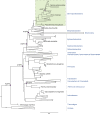Functional Constraints on Replacing an Essential Gene with Its Ancient and Modern Homologs
- PMID: 28851849
- PMCID: PMC5574714
- DOI: 10.1128/mBio.01276-17
Functional Constraints on Replacing an Essential Gene with Its Ancient and Modern Homologs
Abstract
Genes encoding proteins that carry out essential informational tasks in the cell, in particular where multiple interaction partners are involved, are less likely to be transferable to a foreign organism. Here, we investigated the constraints on transfer of a gene encoding a highly conserved informational protein, translation elongation factor Tu (EF-Tu), by systematically replacing the endogenous tufA gene in the Escherichia coli genome with its extant and ancestral homologs. The extant homologs represented tuf variants from both near and distant homologous organisms. The ancestral homologs represented phylogenetically resurrected tuf sequences dating from 0.7 to 3.6 billion years ago (bya). Our results demonstrate that all of the foreign tuf genes are transferable to the E. coli genome, provided that an additional copy of the EF-Tu gene, tufB, remains present in the E. coli genome. However, when the tufB gene was removed, only the variants obtained from the gammaproteobacterial family (extant and ancestral) supported growth which demonstrates the limited functional interchangeability of E. coli tuf with its homologs. Relative bacterial fitness correlated with the evolutionary distance of the extant tuf homologs inserted into the E. coli genome. This reduced fitness was associated with reduced levels of EF-Tu and reduced rates of protein synthesis. Increasing the expression of tuf partially ameliorated these fitness costs. In summary, our analysis suggests that the functional conservation of protein activity, the amount of protein expressed, and its network connectivity act to constrain the successful transfer of this essential gene into foreign bacteria.IMPORTANCE Horizontal gene transfer (HGT) is a fundamental driving force in bacterial evolution. However, whether essential genes can be acquired by HGT and whether they can be acquired from distant organisms are very poorly understood. By systematically replacing tuf with ancestral homologs and homologs from distantly related organisms, we investigated the constraints on HGT of a highly conserved gene with multiple interaction partners. The ancestral homologs represented phylogenetically resurrected tuf sequences dating from 0.7 to 3.6 bya. Only variants obtained from the gammaproteobacterial family (extant and ancestral) supported growth, demonstrating the limited functional interchangeability of E. coli tuf with its homologs. Our analysis suggests that the functional conservation of protein activity, the amount of protein expressed, and its network connectivity act to constrain the successful transfer of this essential gene into foreign bacteria.
Keywords: EF-Tu; ancient genes; horizontal gene transfer; proteobacteria; tuf.
Copyright © 2017 Kacar et al.
Figures




Similar articles
-
Evidence for horizontal gene transfer in evolution of elongation factor Tu in enterococci.J Bacteriol. 2000 Dec;182(24):6913-20. doi: 10.1128/JB.182.24.6913-6920.2000. J Bacteriol. 2000. PMID: 11092850 Free PMC article.
-
Regulation of the synthesis of E. coli elongation factor Tu.Cell. 1981 Jun;24(3):695-706. doi: 10.1016/0092-8674(81)90096-9. Cell. 1981. PMID: 6166386
-
Transfer of plasmid-borne tuf mutations to the chromosome as a genetic tool for studying the functioning of EF-TuA and EF-TuB in the E. coli cell.Biochimie. 1987 Oct;69(10):1021-30. doi: 10.1016/0300-9084(87)90002-2. Biochimie. 1987. PMID: 2964874
-
Elongation factor Tu: a molecular switch in protein biosynthesis.Mol Microbiol. 1992 Mar;6(6):683-8. doi: 10.1111/j.1365-2958.1992.tb01516.x. Mol Microbiol. 1992. PMID: 1573997 Review.
-
Genome dynamics and its impact on evolution of Escherichia coli.Med Microbiol Immunol. 2010 Aug;199(3):145-54. doi: 10.1007/s00430-010-0161-2. Epub 2010 May 6. Med Microbiol Immunol. 2010. PMID: 20445988 Review.
Cited by
-
Network hubs affect evolvability.PLoS Biol. 2019 Jan 30;17(1):e3000111. doi: 10.1371/journal.pbio.3000111. eCollection 2019 Jan. PLoS Biol. 2019. PMID: 30699103 Free PMC article.
-
Evolutionary stalling and a limit on the power of natural selection to improve a cellular module.Proc Natl Acad Sci U S A. 2020 Aug 4;117(31):18582-18590. doi: 10.1073/pnas.1921881117. Epub 2020 Jul 17. Proc Natl Acad Sci U S A. 2020. PMID: 32680961 Free PMC article.
-
The SNAP hypothesis: Chromosomal rearrangements could emerge from positive Selection during Niche Adaptation.PLoS Genet. 2020 Mar 4;16(3):e1008615. doi: 10.1371/journal.pgen.1008615. eCollection 2020 Mar. PLoS Genet. 2020. PMID: 32130223 Free PMC article.
-
Emerging Frontiers in the Study of Molecular Evolution.J Mol Evol. 2020 Apr;88(3):211-226. doi: 10.1007/s00239-020-09932-6. J Mol Evol. 2020. PMID: 32060574 Free PMC article.
-
The origins and evolution of translation factors.Trends Genet. 2025 Jul;41(7):590-600. doi: 10.1016/j.tig.2025.02.004. Epub 2025 Mar 24. Trends Genet. 2025. PMID: 40133153 Review.
References
MeSH terms
Substances
LinkOut - more resources
Full Text Sources
Other Literature Sources

